
Proactive Customer Support Strategies in SaaS: Guide

by
Wiktoria Slowikowska
Oct 17, 2024
Identify and convert your most valuable users
Sign Up
Waiting for customers to come to you with problems is like trying to win a race by standing still. The real winners are those who can anticipate needs, solve issues before they arise, and make customers feel like VIPs. Welcome to the world of proactive customer strategies in SaaS.
Imagine a customer experience so smooth, so tailored, that your users feel like you're reading their minds. It's not science fiction—it's the power of being proactive. Let's dive into how you can transform your SaaS business from reactive to proactive, and in the process, create a loyal customer base that sticks around for the long haul.
Why Go Proactive?
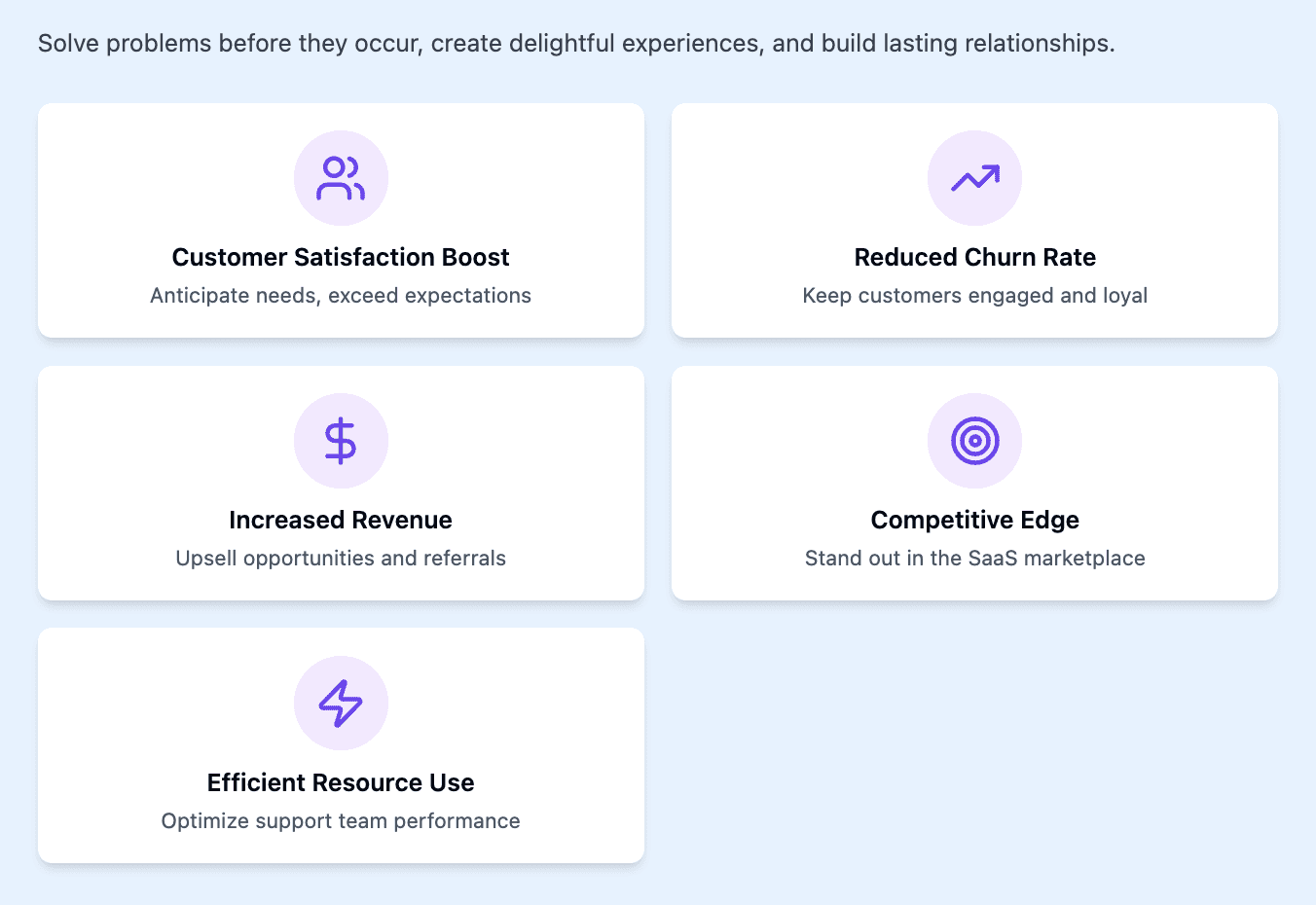
Think back to the last time you had to call customer support. The endless hold music, the frustration, the feeling that you're just another ticket in a long queue. That's reactive customer service, and in today's SaaS landscape, it's as outdated as dial-up internet.
Proactive strategies flip this model on its head. Instead of waiting for customers to come to you with problems, you're reaching out to them with solutions they didn't even know they needed. It's like having a crystal ball that lets you see into the future of your customer relationships.
But why should you care? Here's why going proactive is a game-changer:
Happier customers: When you solve problems before they happen, customers feel taken care of and valued.
Less churn: Happy customers stick around longer, reducing your churn rate and increasing lifetime value.
More money: Loyal customers are more likely to upgrade, buy add-ons, and recommend your service to others.
Standing out: In a crowded SaaS market, being proactive sets you apart from the competition and builds brand loyalty.
Efficient resource use: By addressing issues proactively, you can reduce the strain on your support team and allocate resources more effectively.
Now that we know why it matters, let's explore how to make it happen.
Predictive Analytics
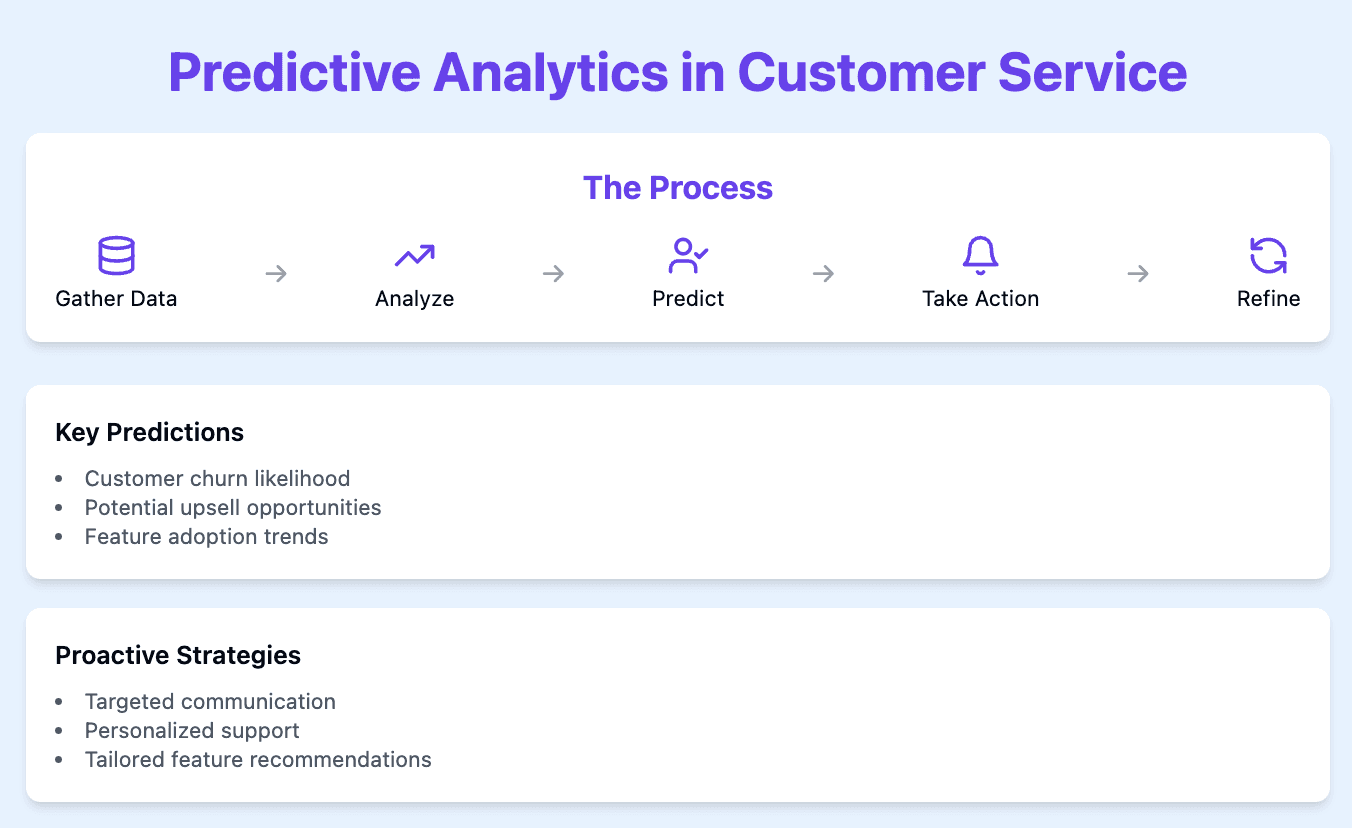
Imagine having a superpower that allows you to foresee customer behavior. That's exactly what predictive analytics offers. By crunching numbers on past behavior, you can get a pretty good idea of what's coming next.
Here's how it works: You gather all the data you can—user activity logs, feature usage stats, support ticket history, billing information—and feed it into smart algorithms. These algorithms then spit out predictions about things like which customers might leave soon, who's ready for an upsell, or which features people are likely to adopt next.
For example, let's say your predictive model flags a customer whose usage has been declining over the past month. Instead of waiting for them to cancel, you can swoop in with a personalized email showcasing features they haven't tried yet, or have a customer success manager give them a call to see if they need help. You might even offer a temporary discount or extra training to re-engage them.
To get started with predictive analytics:
Gather data from all customer touchpoints (app usage, support interactions, billing, etc.)
Choose the right analytics tools for your needs (e.g., Mixpanel, Amplitude, Hyperaktiv)
Build models to predict key outcomes (like churn risk, upsell opportunities, or feature adoption)
Set up alerts and automated actions based on your predictions
Continuously refine your models based on actual outcomes
Remember, the goal isn't just to predict the future, but to shape it. Use your crystal ball wisely to guide customers towards success and long-term engagement with your product.
Personalized Onboarding
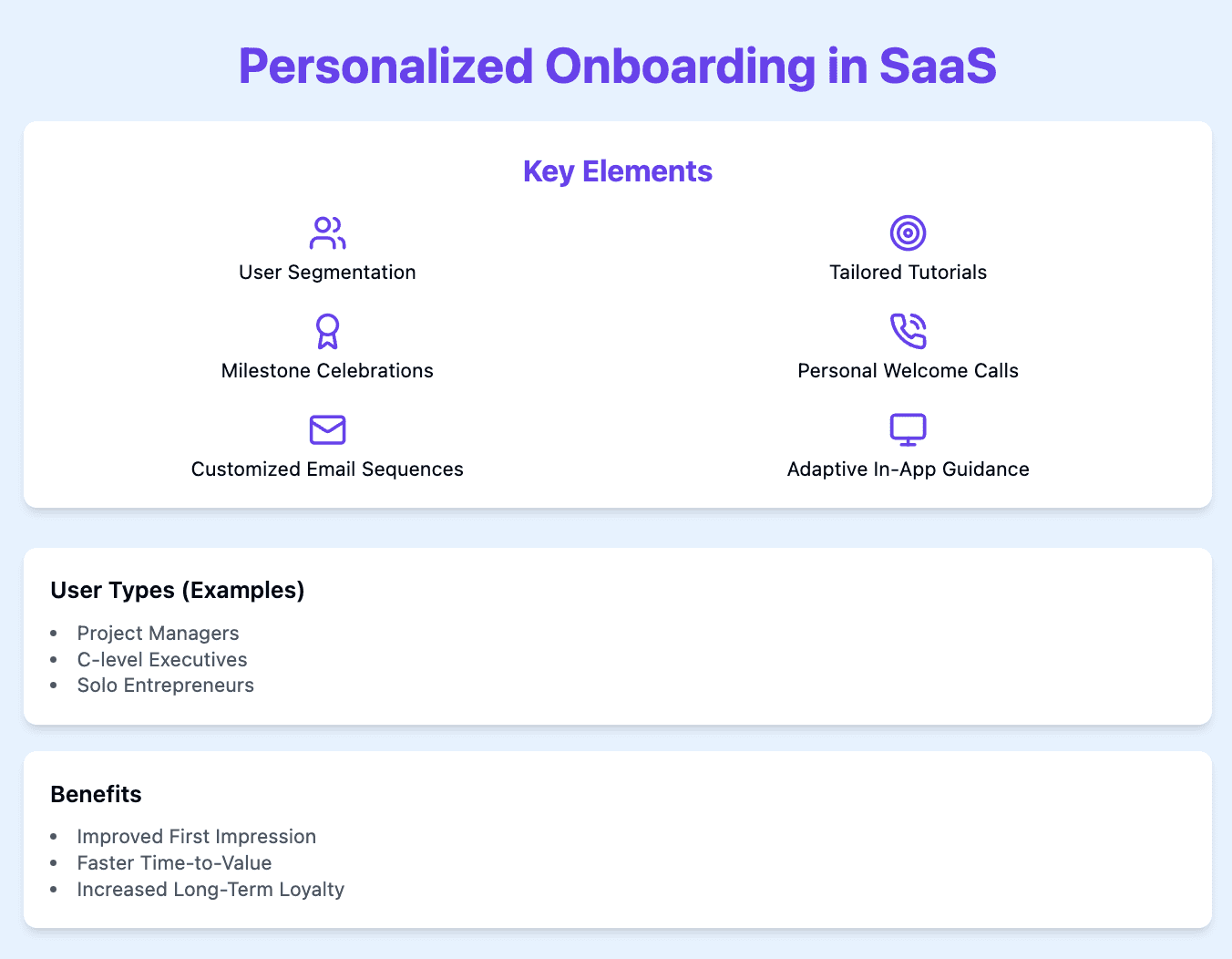
First impressions matter, and in the SaaS world, your onboarding process is that crucial first handshake. A generic, one-size-fits-all approach is about as exciting as lukewarm coffee. Instead, think of onboarding as rolling out the red carpet for each unique customer.
Start by getting to know your users. Are they project managers? C-level executives? Solo entrepreneurs? Each will have different needs and expectations. Use this information to create tailored onboarding experiences that speak directly to each user type.
For instance, a project manager might need a deep dive into collaboration features, while a CEO might be more interested in high-level reporting tools. A solo entrepreneur might appreciate quick-start guides and templates. By customizing the journey, you're showing users from day one that you understand and value their specific needs.
Here's what great personalized onboarding looks like:
User segmentation based on roles, company size, industry, or use cases
Interactive tutorials focused on relevant features for each segment
Personal welcome calls or video sessions for high-value customers
Customized email sequences with tips and best practices tailored to each user type
In-app guidance that adapts based on user behavior and preferences
Don't underestimate the power of the human touch. For your VIP customers, a personal welcome call or demo can go a long way. It's an investment of time that often pays off in long-term loyalty and reduced time-to-value.
Proactive Communication
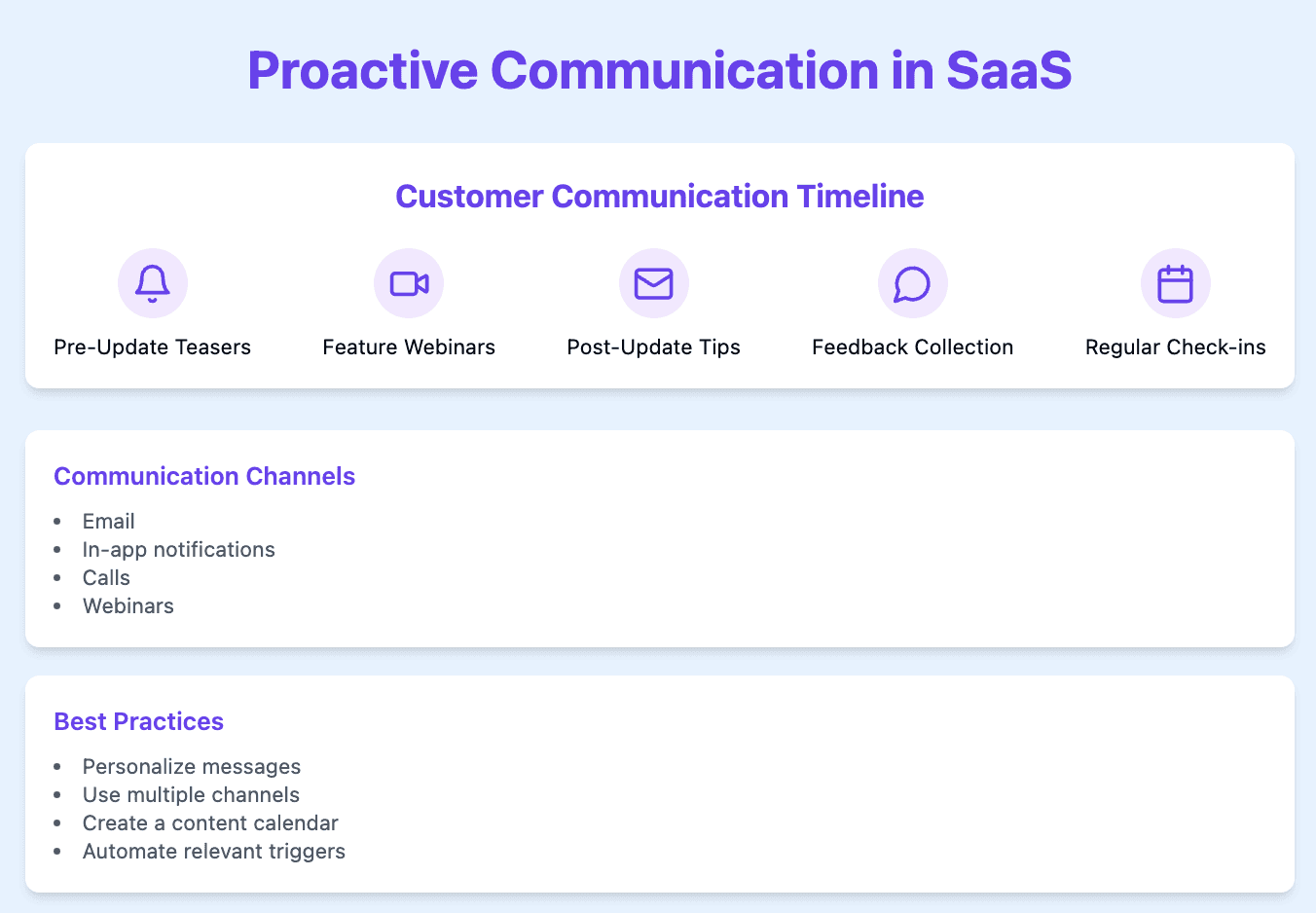
Proactive communication is all about staying one step ahead of your customers' needs. It's the difference between a customer thinking, "I wish they had told me about this sooner," and "Wow, they really have my back!"
Think of it as being the friend who always remembers your birthday, rather than the one who sends a belated text a week later. In the SaaS world, this might mean sending a heads-up about scheduled maintenance before it happens, or reaching out with tips on using a feature you've noticed they haven't tried yet.
For example, if you're planning a major update, don't just spring it on your customers. Create a whole communication campaign around it. Start with teaser emails highlighting cool new features. Follow up with in-app notifications giving sneak peeks. Host webinars showing how the new stuff works. After the update, send out emails with tips for using the new features. And don't forget to ask for feedback!
Here's how to nail proactive communication:
Plan regular check-ins throughout the customer lifecycle (e.g., 30-day check-in, quarterly reviews)
Personalize messages based on customer segments and individual usage patterns
Use multiple channels (email, in-app notifications, calls, webinars) to reach customers where they are
Always follow up and ask for feedback after big changes or interactions
Create a content calendar to ensure consistent, timely communication
Use automation to trigger relevant messages based on user actions or milestones
Remember, the goal isn't just to bombard customers with information, but to make them feel cared for and valued. It's about building a relationship, not just sending notifications.
Customer Health Scoring: Your Early Warning System
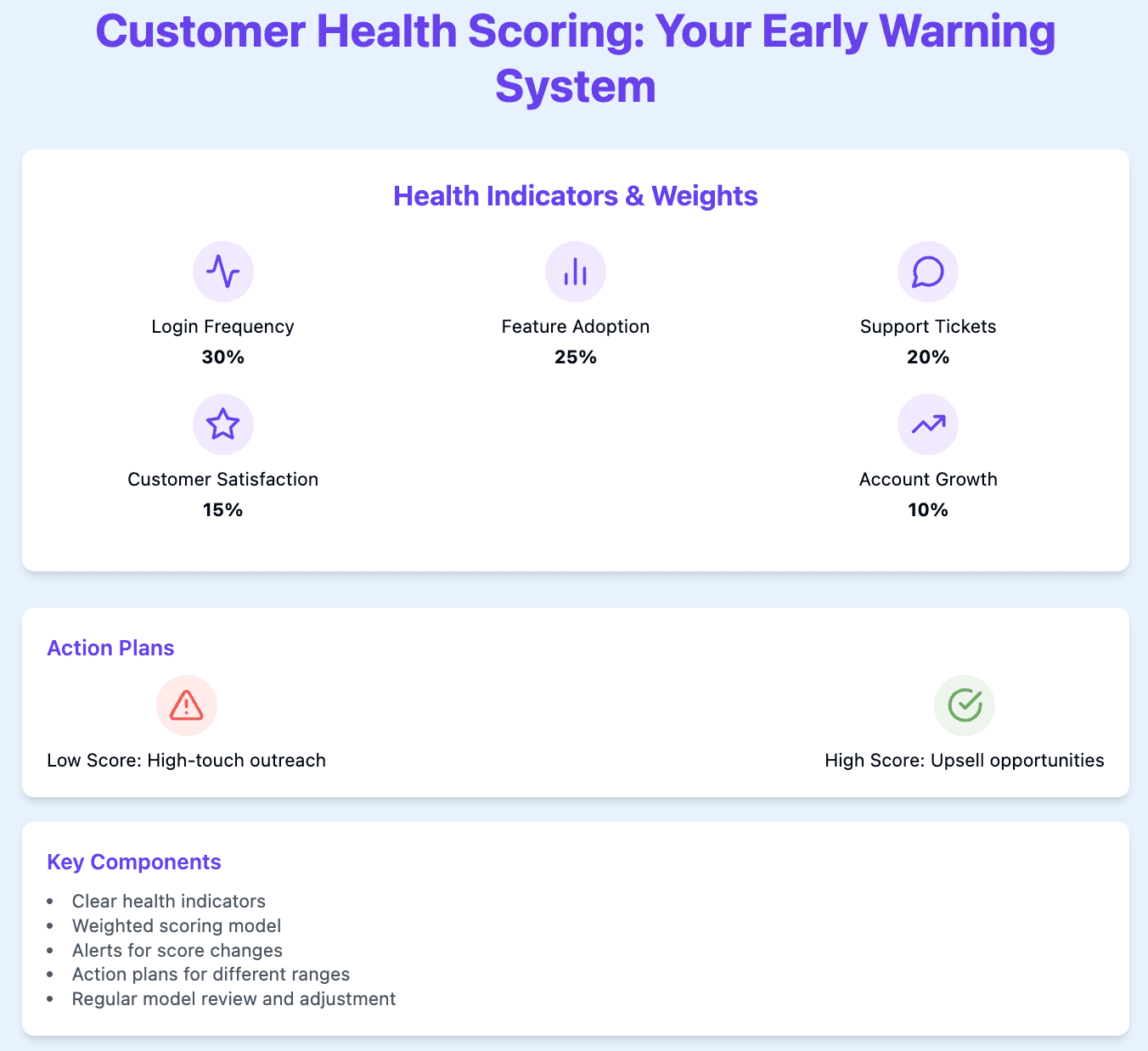
Think of customer health scoring as your SaaS company's version of a doctor's check-up. Just like a doctor uses things like blood pressure and heart rate to gauge your health, you can use various metrics to assess the health of your customer relationships.
The trick is figuring out which metrics matter most for your business. It might be how often customers log in, how many features they use, how many support tickets they submit, or how they rate your service. The magic happens when you combine these metrics into a single, easy-to-understand score.
For instance, you might decide that login frequency counts for 30% of the health score, feature adoption for 25%, support tickets for 20%, customer satisfaction ratings for 15%, and account growth for 10%. The resulting score gives you a quick snapshot of each customer's status.
Here's what you need for a solid health scoring system:
Clear health indicators (like usage frequency, feature adoption, support interactions)
A weighted scoring model that reflects the relative importance of each indicator
Alerts for when scores drop below certain thresholds or change rapidly
Action plans for different score ranges (e.g., high-touch outreach for low scores, upsell opportunities for high scores)
Regular review and adjustment of your scoring model based on actual outcomes
But remember, a score is just a number unless you do something with it. Set up alerts for when scores change significantly, and have plans ready for how to respond. If a customer's score starts to slip, it might be time for a check-in call, a personalized assistance plan, or even a special offer to re-engage them.
The goal isn't just to watch the numbers, but to actively improve them. Think of it as preventive care for your customer relationships. By catching issues early, you can often turn things around before a customer even thinks about leaving.
Continuous Feedback
The final piece of the proactive puzzle is creating a continuous feedback loop. This isn't about sending out a survey once a year and calling it a day. It's about creating an ongoing conversation with your customers.
Think of it like being in a relationship. You don't wait for your annual anniversary dinner to ask your partner how things are going, right? You check in regularly, listen actively, and make adjustments as needed. The same principle applies to your customers.
Use a mix of feedback channels. Quick in-app surveys can give you real-time insights. Longer email surveys can dig deeper into specific issues. For your most valuable customers, quarterly review calls can provide rich, detailed feedback. And for strategic direction, consider setting up a customer advisory board.
But here's the kicker: collecting feedback is only half the battle. The real magic happens when you close the loop. Always acknowledge the feedback you receive, even if you can't act on it right away. Let customers know how their input is shaping your product roadmap. And when you implement changes based on feedback, shout it from the rooftops!
Here's how to create a killer feedback loop:
Use diverse feedback channels (surveys, calls, advisory boards, social media monitoring)
Have a system for routing feedback to the right teams (product, support, development)
Regularly review and act on the feedback you receive
Communicate back to customers about how you're using their input
Create a public product roadmap that shows how customer feedback influences your plans
Celebrate customers whose feedback leads to improvements
By integrating feedback into your product development process, you're not just improving your product—you're making customers feel heard and valued. And that's a recipe for long-term loyalty.
Implementing Proactive Strategies
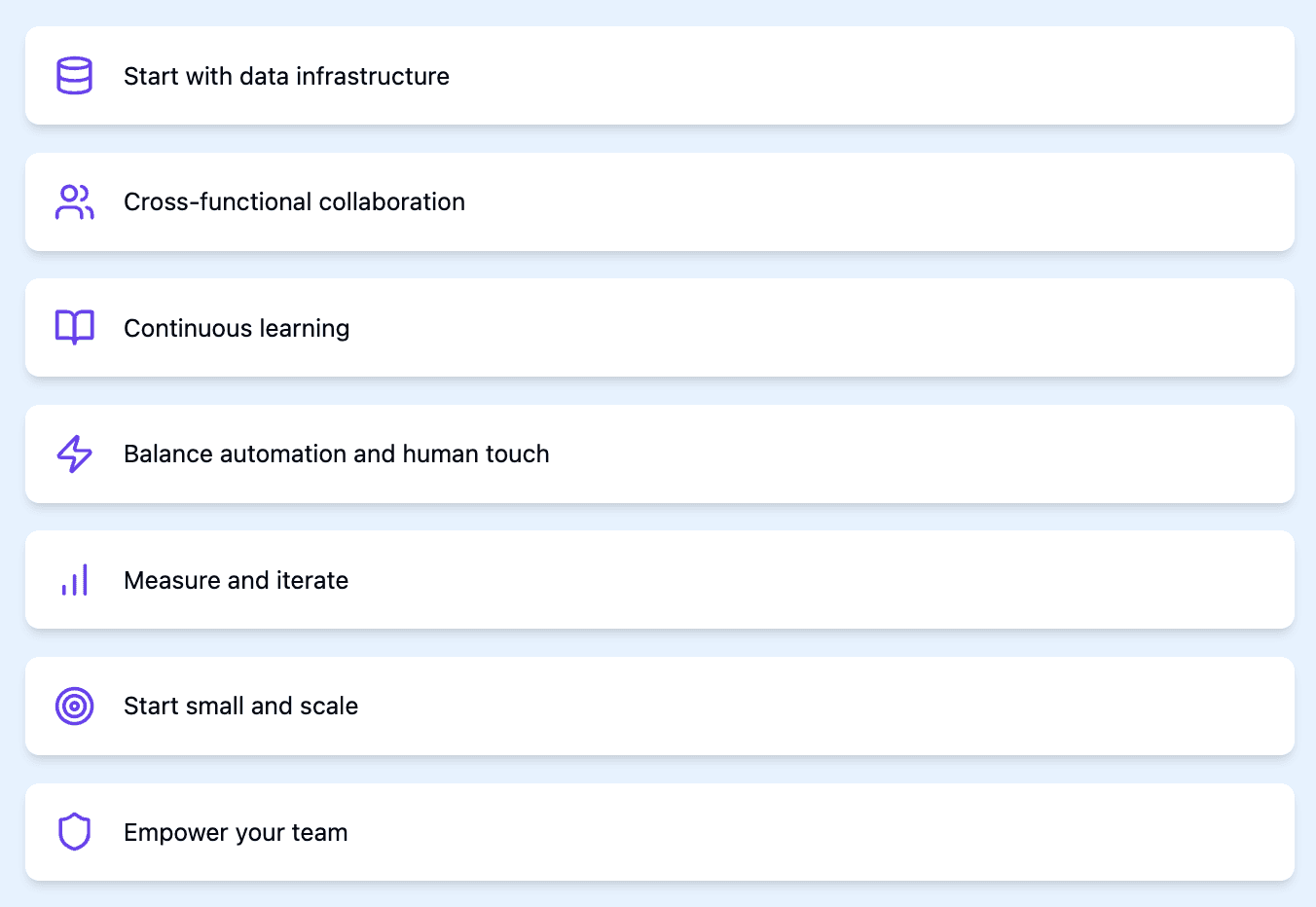
While understanding proactive strategies is crucial, implementing them effectively can be challenging. Here are some best practices to consider as you embark on your proactive journey:
Start with data infrastructure: Ensure you have robust data collection and analysis systems in place. This might involve investing in customer data platforms (CDPs) or upgrading your current CRM system.
Cross-functional collaboration: Proactive strategies often require input from multiple departments. Foster collaboration between your customer success, product and marketing teams.
Continuous learning: The SaaS landscape is always evolving. Stay updated on the latest trends and technologies in customer experience and data analytics.
Balance automation and human touch: While automation is crucial for scaling proactive efforts, don't lose the personal touch. Find the right balance between automated systems and human intervention.
Measure and iterate: Regularly assess the effectiveness of your proactive strategies. Use metrics like Net Promoter Score (NPS), Customer Effort Score (CES), and customer lifetime value (CLV) to gauge success.
Start small and scale: Begin with one or two proactive strategies, perfect them, and then expand your efforts based on results.
Empower your team: Provide your customer-facing teams with the tools and authority to take proactive actions when they spot opportunities.
Overcoming Common Challenges
Implementing proactive strategies isn't without its hurdles. Here are some common challenges and ways to address them:
Data silos: Information scattered across different systems can hinder proactive efforts. Implement data integration solutions to create a unified view of your customers.
Resource constraints: Proactive strategies require investment. Start small, prove the ROI, and gradually scale your efforts.
Customer privacy concerns: With increased data usage comes the responsibility of protecting customer information. Ensure compliance with data protection regulations and be transparent about your data practices.
Resistance to change: Shifting from reactive to proactive can be a significant culture change. Provide training and showcase early wins to get buy-in from all levels of the organization.
Balancing proactivity with intrusiveness: Be mindful of not overwhelming customers with too many touchpoints. Always provide options to adjust communication preferences.
Wrapping Up
Implementing these proactive strategies isn't a one-and-done deal—it's a journey of constant improvement and adaptation. Start by looking at your current customer engagement strategies. Where can you inject more proactivity? Prioritize based on what will have the biggest impact and what's feasible for your team.
Don't be afraid to start small. Pick one strategy, implement it well, and then move on to the next. Rome wasn't built in a day, and neither is a proactive customer strategy.
Most importantly, make proactivity a part of your company culture. When everyone in your organization is focused on anticipating and addressing customer needs, that's when the magic really happens.
Remember, in the SaaS world, being reactive is like showing up to a party after everyone's gone home. By consistently staying one step ahead, solving problems before they escalate, and actively adding value at every turn, you'll not only keep customers around longer but turn them into raving fans.
The future of SaaS belongs to those who can see around corners and delight customers before they even know what they want. With these proactive strategies in your toolkit, you're well-equipped to lead the charge into this exciting new frontier of customer relationships.
So, are you ready to transform your SaaS from reactive to revolutionary? Your customers are waiting. The only question is: How will you wow them first?




